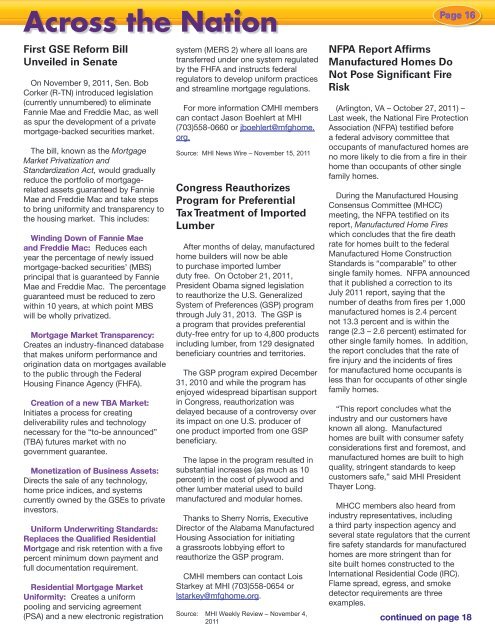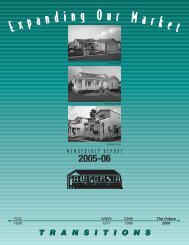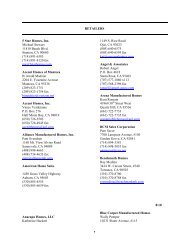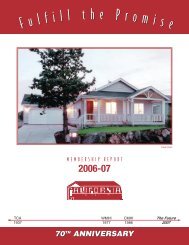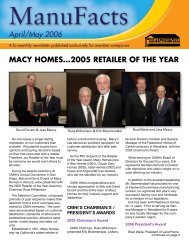joe stegmayer & j.c. strutzel recipients of prestigious awards
joe stegmayer & j.c. strutzel recipients of prestigious awards
joe stegmayer & j.c. strutzel recipients of prestigious awards
You also want an ePaper? Increase the reach of your titles
YUMPU automatically turns print PDFs into web optimized ePapers that Google loves.
Across the Nation<br />
First GSE Reform Bill<br />
Unveiled in Senate<br />
On November 9, 2011, Sen. Bob<br />
Corker (R-TN) introduced legislation<br />
(currently unnumbered) to eliminate<br />
Fannie Mae and Freddie Mac, as well<br />
as spur the development <strong>of</strong> a private<br />
mortgage-backed securities market.<br />
The bill, known as the Mortgage<br />
Market Privatization and<br />
Standardization Act, would gradually<br />
reduce the portfolio <strong>of</strong> mortgagerelated<br />
assets guaranteed by Fannie<br />
Mae and Freddie Mac and take steps<br />
to bring uniformity and transparency to<br />
the housing market. This includes:<br />
Winding Down <strong>of</strong> Fannie Mae<br />
and Freddie Mac: Reduces each<br />
year the percentage <strong>of</strong> newly issued<br />
mortgage-backed securities’ (MBS)<br />
principal that is guaranteed by Fannie<br />
Mae and Freddie Mac. The percentage<br />
guaranteed must be reduced to zero<br />
within 10 years, at which point MBS<br />
will be wholly privatized.<br />
Mortgage Market Transparency:<br />
Creates an industry-financed database<br />
that makes uniform performance and<br />
origination data on mortgages available<br />
to the public through the Federal<br />
Housing Finance Agency (FHFA).<br />
Creation <strong>of</strong> a new TBA Market:<br />
Initiates a process for creating<br />
deliverability rules and technology<br />
necessary for the “to-be announced”<br />
(TBA) futures market with no<br />
government guarantee.<br />
Monetization <strong>of</strong> Business Assets:<br />
Directs the sale <strong>of</strong> any technology,<br />
home price indices, and systems<br />
currently owned by the GSEs to private<br />
investors.<br />
Uniform Underwriting Standards:<br />
Replaces the Qualified Residential<br />
Mortgage and risk retention with a five<br />
percent minimum down payment and<br />
full documentation requirement.<br />
Residential Mortgage Market<br />
Uniformity: Creates a uniform<br />
pooling and servicing agreement<br />
(PSA) and a new electronic registration<br />
system (MERS 2) where all loans are<br />
transferred under one system regulated<br />
by the FHFA and instructs federal<br />
regulators to develop uniform practices<br />
and streamline mortgage regulations.<br />
For more information CMHI members<br />
can contact Jason Boehlert at MHI<br />
(703)558-0660 or jboehlert@mfghome.<br />
org.<br />
Source: MHI News Wire – November 15, 2011<br />
Congress Reauthorizes<br />
Program for Preferential<br />
Tax Treatment <strong>of</strong> Imported<br />
Lumber<br />
After months <strong>of</strong> delay, manufactured<br />
home builders will now be able<br />
to purchase imported lumber<br />
duty free. On October 21, 2011,<br />
President Obama signed legislation<br />
to reauthorize the U.S. Generalized<br />
System <strong>of</strong> Preferences (GSP) program<br />
through July 31, 2013. The GSP is<br />
a program that provides preferential<br />
duty-free entry for up to 4,800 products<br />
including lumber, from 129 designated<br />
beneficiary countries and territories.<br />
The GSP program expired December<br />
31, 2010 and while the program has<br />
enjoyed widespread bipartisan support<br />
in Congress, reauthorization was<br />
delayed because <strong>of</strong> a controversy over<br />
its impact on one U.S. producer <strong>of</strong><br />
one product imported from one GSP<br />
beneficiary.<br />
The lapse in the program resulted in<br />
substantial increases (as much as 10<br />
percent) in the cost <strong>of</strong> plywood and<br />
other lumber material used to build<br />
manufactured and modular homes.<br />
Thanks to Sherry Norris, Executive<br />
Director <strong>of</strong> the Alabama Manufactured<br />
Housing Association for initiating<br />
a grassroots lobbying effort to<br />
reauthorize the GSP program.<br />
CMHI members can contact Lois<br />
Starkey at MHI (703)558-0654 or<br />
lstarkey@mfghome.org.<br />
Source: MHI Weekly Review – November 4,<br />
2011<br />
NFPA Report Affirms<br />
Manufactured Homes Do<br />
Not Pose Significant Fire<br />
Risk<br />
Page 16<br />
(Arlington, VA – October 27, 2011) –<br />
Last week, the National Fire Protection<br />
Association (NFPA) testified before<br />
a federal advisory committee that<br />
occupants <strong>of</strong> manufactured homes are<br />
no more likely to die from a fire in their<br />
home than occupants <strong>of</strong> other single<br />
family homes.<br />
During the Manufactured Housing<br />
Consensus Committee (MHCC)<br />
meeting, the NFPA testified on its<br />
report, Manufactured Home Fires<br />
which concludes that the fire death<br />
rate for homes built to the federal<br />
Manufactured Home Construction<br />
Standards is “comparable” to other<br />
single family homes. NFPA announced<br />
that it published a correction to its<br />
July 2011 report, saying that the<br />
number <strong>of</strong> deaths from fires per 1,000<br />
manufactured homes is 2.4 percent<br />
not 13.3 percent and is within the<br />
range (2.3 – 2.6 percent) estimated for<br />
other single family homes. In addition,<br />
the report concludes that the rate <strong>of</strong><br />
fire injury and the incidents <strong>of</strong> fires<br />
for manufactured home occupants is<br />
less than for occupants <strong>of</strong> other single<br />
family homes.<br />
“This report concludes what the<br />
industry and our customers have<br />
known all along. Manufactured<br />
homes are built with consumer safety<br />
considerations first and foremost, and<br />
manufactured homes are built to high<br />
quality, stringent standards to keep<br />
customers safe,” said MHI President<br />
Thayer Long.<br />
MHCC members also heard from<br />
industry representatives, including<br />
a third party inspection agency and<br />
several state regulators that the current<br />
fire safety standards for manufactured<br />
homes are more stringent than for<br />
site built homes constructed to the<br />
International Residential Code (IRC).<br />
Flame spread, egress, and smoke<br />
detector requirements are three<br />
examples.<br />
continued on page 18


